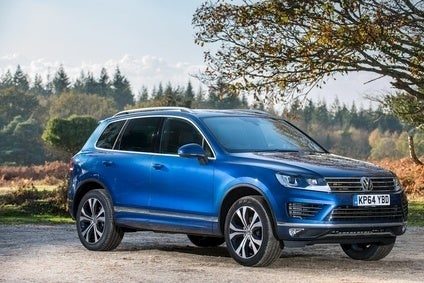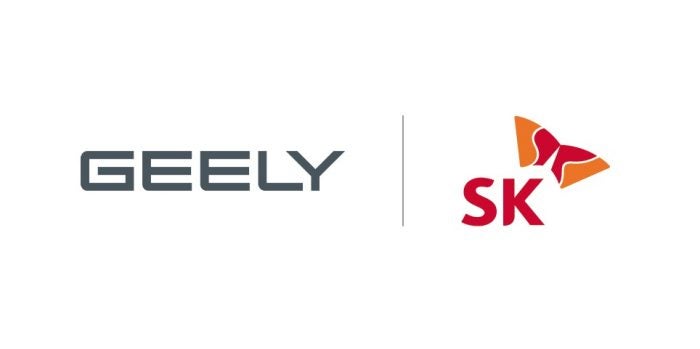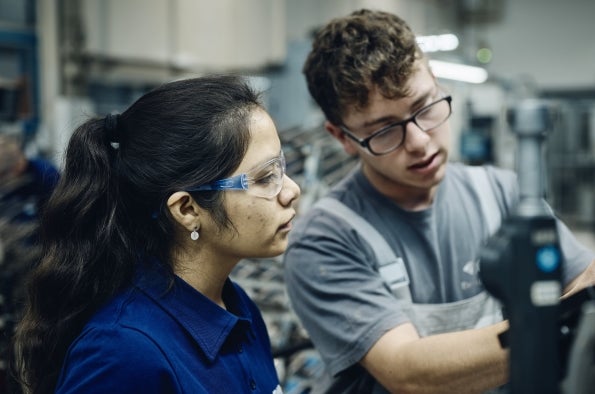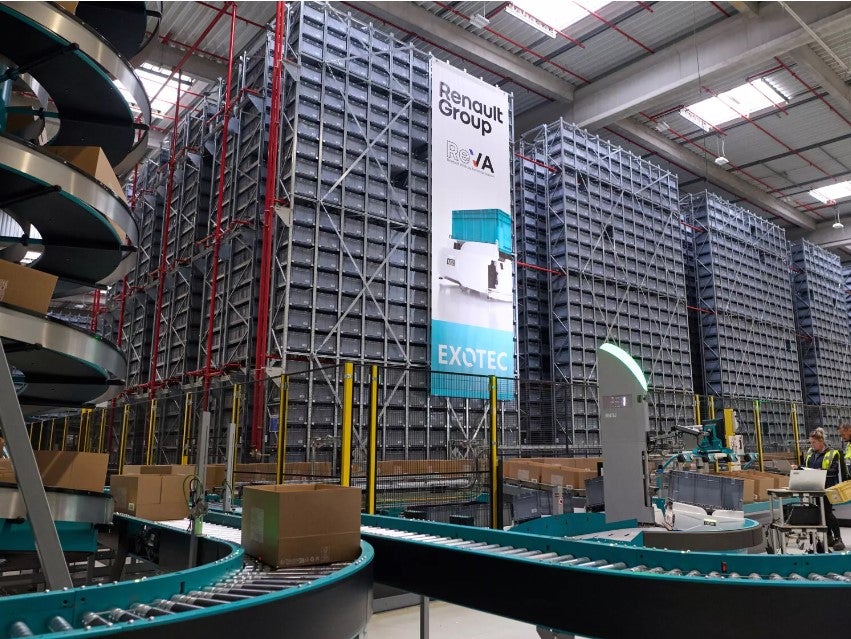
The need for Euro 6 compliancy has seen Volkswagen fitting the facelifted Touareg with a new 3.0-litre V6 diesel. There are also interesting plans for VW’s global SUV strategy, with multiple models in the future products pipeline.
Might the recent success of the new XC90 in one European market represent the start of a new growth for mass-premium big crossovers and SUVs? Perhaps, as buyers in so many countries now think twice before settling for another 5 Series, E-Class, A6 or in Britain, XF. And it is extraordinary the brands that people will compare. Mazda in Europe is becoming premium, while the latest Sorento can easily be a GBP40,000 car and 65% of the first 350 ordered were in the top two trim levels, according to Kia Motors’ UK press office.
The Touareg then, fits nicely into a segment where price isn’t all. This SUV has always been a bit different from the norm, in any case – could you imagine Ford or Hyundai putting a ten cylinder engine into an E-segment 4×4? The V10 TDI was even sold in the USA for a time. Pricing was sky-high but no surprise that sales were not. Still, that didn’t matter.
As applies to the Sorento, big-number versions of the basic model lift the brand’s overall ability to command higher list prices. Peugeot is discovering this with its 308 GT, Ford wants a part of it for the S-MAX and Mondeo Vignale experiment, and Renault is keen for the Initiale Paris versions of the Clio and Espace to work.
Volkswagen has never really had a problem charging people a fair bit more for equivalent models. Witness how the new Passat and Mondeo compare, and VW is unlikely to drop Golf prices when the new Astra arrives in Q4, such is its brand power. The Touareg I recently tried out was listed at GBP43,320 and for once here was a press test car that wasn’t loaded with extras. For the money, you get the SE model grade but there are two other levels above this: Escape and R-Line. All-wheel drive is standard, as is a diesel engine, though there are several options of the latter. The Hybrid and V8 TDI were long gone from the UK market but now they have been killed off in the rest of Europe too, as we recently reported.
Volkswagen UK sees 40% of Touaregs being sold to retail buyers, with the rest obviously going to fleets. The most popular trim and engine combination is R-Line, with a 262PS version of the Group’s 3.0-litre V6 diesel. The off-road biased Escape model grade is only about 10% of sales. This has a different 4×4 system for extra off-road capability. There is a two-speed transfer gearbox, centre and rear diffs (each of which can be fully locked), and five-stage control for the four-wheel drive system.
How well do you really know your competitors?
Access the most comprehensive Company Profiles on the market, powered by GlobalData. Save hours of research. Gain competitive edge.

Thank you!
Your download email will arrive shortly
Not ready to buy yet? Download a free sample
We are confident about the unique quality of our Company Profiles. However, we want you to make the most beneficial decision for your business, so we offer a free sample that you can download by submitting the below form
By GlobalDataThe lower-power version of the V6 TDI produces 204PS and I did find it lacking a bit of oomph a few times which prevented me overtaking with a safe margin. Off the mark, it’s brisk though, thanks to 450Nm of torque, which makes it great for towing. My advice would be to pay up for the 262PS engine. All Touaregs have an eight-speed gearbox and it was odd not to have paddle shifters when so many cars now feature these. Zero to 62mph takes 8.7 seconds, top speed is just 128mph, and CO2 is 173g/km. Real world economy should be around the 30-35mpg mark if my driving was typical, though Combined is an official 42.8mpg.
Unlike the new Passat, the Touareg does not have the filler for AdBlue located under the fuel flap. Instead, you must lift the boot floor’s carpeted panel and then extract a nasty-cheap piece of hard and squeaky foam, before pouring the liquid directly into the tank. This is circular in shape, reminding you that there is no spare tyre where you would normally see one stored. How do you know if your VW model needs this additive? It will have SCR in the model name. Topping up doesn’t need to happen very often and it’s likely than most buyers won’t know about AdBlue until they see it itemised on a servicing receipt.
In common with most cars’ infotainment systems now, the one in the Touareg took some time to fully come alive, which can be irritating if you expect the SatNav to be ready the moment the ignition key is turned. Something new for a Volkswagen Group model was the lack of a CD player in the glovebox – finally this technology is vanishing. The as-expected high quality interior is there, the door pockets are deep and soft-lined but there is manual steering wheel adjustment and no heating for the rim either. That Sorento I mentioned earlier is both cheaper and better equipped.
The engine is quiet but almost sporty sounding when you press your right foot down hard. Despite this being a four-year old model which has just been updated, it handles well and doesn’t roll much (see for yourself in this video). It’s a shame that there are only five seats but the boot is vast. On narrow roads, you will feel the car’s width but it’s no worse than its cousins the outgoing Audi Q7 and current Porsche Cayenne.
The Touareg isn’t a segment leader, as good as it is, but that probably doesn’t matter too much to Volkswagen. As a model which helps enormously to keep the brand’s often high pricing justified, it does an excellent job. How will the company replace it when this second generation model reaches the end of the line in around 2017? The answer is slightly complex. To see why, it’s best to set out the brand’s current crossovers and SUVs in size/price order:
- Crossup!
- CrossFox & CrossSaveiro (Brazil)
- CrossPolo
- Golf Alltrack
- Tiguan
- Long wheelbase Tiguan (China)
- Passat Alltrack
- Touareg
The list is long but only two of these are true SUVs, the Tiguan series and the Touareg. North America, where Volkswagen has missed hundreds of thousands of sales due its lack of SUVs, is the brand’s co-target for a new model, to be based on the CrossBlue and CrossBlue L concepts. Will these standard and LWB big SUVs replace the Touareg? That does seem to make sense, given that they their size was not dissimilar to that of the big sellers in North America, namely the Ford Explorer and Toyota Highlander.
There is slight confusion in that the Touareg is still only five years old so should remain in production until 2017 or later, if it’s on a normal VW lifecycle. However, Volkswagen of America says it will in 2016 begin building a production model closely linked to the CrossBlue. This, a seven-seater, will be made on a new line at Chattanooga. The model should share its MQB platform with North America’s next generation Passat.
A shorter version of the US’ model shuld be made in China by FAW Volkswagen from 2017, based on the CrossBlue Coupe concept. This had only two rows of seats and its stated dimensions were similar to those of the Touareg. Shanghai Volkswagen’s Changsha plant, meanwhile, is expected to build the LWB version, also from 2017. This plant had a stated annual capacity of 300,000 vehicles a year when it opened just a few weeks ago.
Once CrossBlue and its L variant are in production in China and the US, we will likely see a Touareg replacement for Europe and other markets, based on these two, but built in the same Bratislava plant which makes VW526, the current T5 platform model. There have been some rumours of a Touareg ‘CC’ as a supposed cheaper rival for the BMW X6 but is there really a market for such a Volkswagen?
What there most definitely is a huge market for, is a new Tiguan. This car is so overdue, it’s ridiculous. Volkswagen has lost its leadership of the compact SUV segment in China and it might never regain it. That’s due to Great Wall’s Haval H5 having become the number one model there. This brand is going to be a big threat not just to VW but to all other SUV ranges, as its additional models pour into ever more SUV segments in the Chinese market. The replacement for the Tiguan should have its debut at the Frankfurt IAA in three months’ time and enter production in Q4.
The next Tiguan, VW326, will be a big deal. Production will be in far greater volumes than the current model, with Puebla added to the list of plants which will make it, along with two in Germany (Wolfsburg and Hanover), and one in China (FAW Volkswagen: either Ningbo or Yizheng). Russia (Kaluga) and India are two other as yet unconfirmed locations.
Sitting below the next Tiguan will be two other SUVs, already seen as concepts called T-ROC and Taigun. These will take on the Ford EcoSport, Nissan Juke, Chevy Trax, Buick Encore, Opel/Vauxhall Mokka, Hyundai ix25/Creta and multiple other entrants in the B/C segments.
Why two? The Tiguan will become larger and as models such as the Peugeot 2008, Renault Captur, Fiat 500X, Jeep Renegade and Suzuki Vitara demonstrate, vehicle length varies greatly in these classes, even among supposed direct rivals. The length of the Taigun will be 3,859mm according to VW, while the T-ROC, a concept which debuted at the 2014 Geneva show, was 4,179mm long. This made it around 200mm shorter than a first generation Tiguan, and some 300mm longer than the Taigun concept. At 1,501mm tall it was around 200mm lower than a Tiguan.
As the Taigun was first revealed as a concept in Brazil, it’s likely to be mainly for lower income markets. It should do well there, and also in China and India. The larger T-ROC is likely to be aimed at Europe.
From being currently a global underperformer when it comes to the hottest segments for SUVs and crossovers, Volkswagen will soon be seeking to become if not dominant, then at least a major force in Europe, South America, China and to a lesser extent, North America.
In his next Future models and vehicle review, Glenn Brooks will examine Audi’s plans, after sampling the new TTS.








